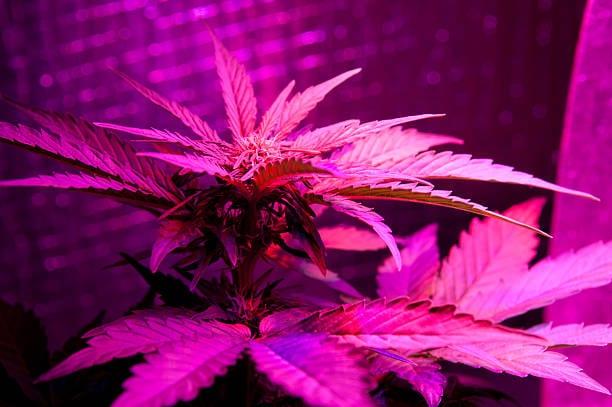by SAM MILTON PRINCIPAL OF CLIMATE RESOURCES GROUP Ι MARCH, 7TH, 2018
At yesterday’s public meeting at the Massachusetts State House, the
Cannabis Control Commission (CCC) agreed to include recommendations from the Massachusetts Executive Office of Energy and Environmental Affairs in their final regulations, which will be filed by March 15th of this year. This decision puts Massachusetts light-years ahead of any other state in regulating the energy and environmental impact of legal cannabis cultivation and product manufacturing.
Several of the proposed regulations are groundbreaking in their own right, and in sum they are a BFD (to paraphrase Joe Biden). But what are they? What are their implications for the cannabis industry? And should advocates for a greener cannabis industry have buyer’s remorse?
A lighting power density (LPD) standard of no more than 36 watts (W) per square foot of canopy for a cultivation facility with over 5,000 ft² of canopy
For smaller facilities, the commission establishes a LPD standard of 50 W per square foot. This is a huge development, as these regulations effectively prohibit the use of any lighting technology that uses more power than LEDs, which directly impacts those growers that favor the popular (and relatively inexpensive and inefficient) high-intensity discharge (HID) and high-pressure sodium (HPS) lamps. These regulations will have a profound impact on both the upfront and ongoing costs of operating an indoor cannabis cultivation facility in Massachusetts; currently, LED lights can cost three to four times as much as an HPS light, but on the flipside, they last much longer and can reduce electricity usage by up to 40%. One unfortunate catch to this regulation is that utilities will now no longer be able offer cash rebates to growers who use efficient lighting at the 36 W/ft2 standard, since their use will be mandated by regulation.
The question is whether this will affect utilities’ other incentives for controlled environment agriculture. How will the market for better-than-standard lights evolve in order to qualify for utility rebates? Higher standards will undoubtedly cause demand for LEDs to skyrocket, which may have the unfortunate and unintended effect of putting more cheaply made, low-quality lights into grow operations. I expect that as the market stabilizes and quality manufacturers out-compete shoddy ones, we will see this effect go away.
What will be the cumulative effect in the process? How will this affect lighting innovation? Moreover, how will this regulation affect efforts to find the “perfect” lighting efficiency standard? Groups such as the DesignLights Consortium and the New Buildings Institute have been considering this question for several years now. Yet, the question remains whether this regulation will be the impetus to reinvigorate the discussion.
Building and HVAC codes
The building envelope for all facilities, except greenhouses, and Heating Ventilation and Air Conditioning (HVAC) and dehumidification systems must meet minimum Massachusetts Building Code requirements and relevant IECC and ASHRAE chapters. Adherence to codes and standards is important, but experience from other states has found that applying existing building codes to indoor agriculture facilities may have a perverse effect on efficiency and overall cost effectiveness. After all, these codes were indented for buildings occupied by human beings, not plants. Will cannabis regulations supercharge efforts to develop horticulture-specific building codes? How long will this take, and what will be the unintended impact of this regulation in the meantime?
A waiver to LPD and HVAC codes if licensees use electricity from 100% renewable energy sources
The CCC approved language providing a waiver for the lighting power density and HVAC code standards if the license holder uses 100% renewable energy equal to its onsite electricity consumption. However, EEA’s language is not clear if the power needs to be generated onsite or if the licensee can purchase Renewable Energy Credits (RECs). This is a big difference, as very few (if any) cultivators can meet 100% of their load with onsite generation.
Energy use disclosure
The CCC adopted a recommendation submitted by the Resource Innovation Institute and others to require cultivation licensees to provide energy use data on an annual basis. This is a critical yet fairly painless ask that will move the whole industry towards energy use best (or at least better) practices. It’s not clear yet what the Commission intends to do with this data, but I hope they take the opportunity to analyze it for trends and incorporate the analysis into future changes to the regulations and or its best practices guides.
Energy planning
The CCC adopted specific energy and water planning language. Specifically, all marijuana establishments must demonstrate consideration of:
– opportunities for renewable energy generation,
– strategies to reduce electric demand,
– engagement with state and utility energy efficiency programs, and
– potential energy use reduction opportunities.
Thoughtful consideration of the above items will take effort, but they are the necessary and valuable precursor to identifying and seizing important resource conservation and cost-savings opportunities. All cultivators should welcome this opportunity.
All in all, absorbing the implication of these regulations will take some time, but make no mistake, the CCC’s decision shows that the Commonwealth of Massachusetts is serious about meeting itstargets for clean energy adoption and carbon emissions reductions, all of which precede the adult-use marijuana market by nearly a decade. Further, I expect that the innovation driven by these regulations will result in Massachusetts cultivators being at the vanguard of growers nationwide and can help drive best practices across the country.
 SAM MILTON PRINCIPAL OF CLIMATE RESOURCES GROUP
SAM MILTON PRINCIPAL OF CLIMATE RESOURCES GROUP
Sam is a seasoned climate and energy policy professional, with years of experience in the energy and environmental sectors. He excels at creating strategic partnerships and engaging a range of consumer, industry, public and non-profit stakeholders for mutual gains. He is experienced in creating data-driven corporate and institutional programs and analyzing public policy and government regulations that affect energy development. He is fluent in sustainability science, is knowledgeable about best practices to advance adoption of clean energy and energy efficiency measures, and is a passionate advocate for technological advances for improving the human condition. Sam holds a Bachelor’s Degree from Beloit College and a Master’s in Law and Diplomacy from the Fletcher School at Tufts University, with a concentration in Environmental Policy and Development Economics.









